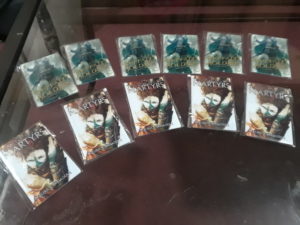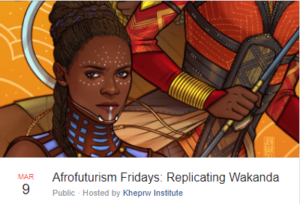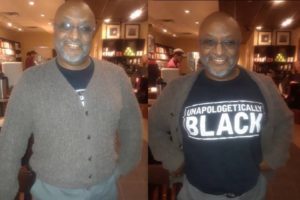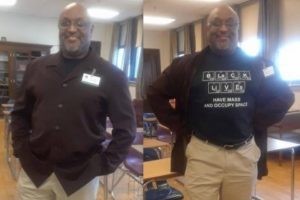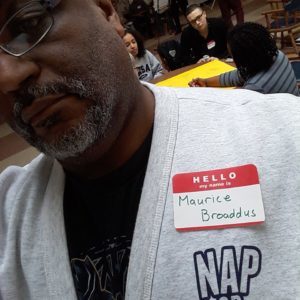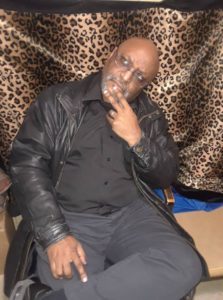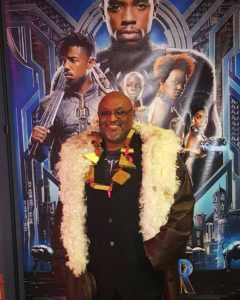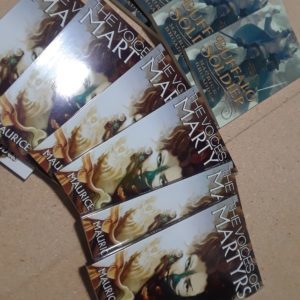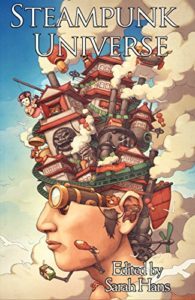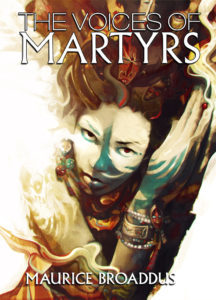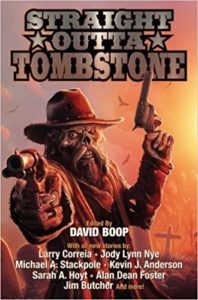Maurice Broaddus's Blog, page 11
April 6, 2018
Upcoming Workshops
I’ve been getting a lot of (well-earned) grief about not publicizing my workshops and such. I try to keep my appearances updated on my web site, but here are some upcoming events:
Afrofuture Fridays – the second Friday of the month, I’ll be at the Kheprw Institute leading a community conversation on Afrofuturism and applying those themes to community work. Here are links to our introduction and out Black Panther conversations. Indiana Humanities has awarded us a $4,000 grant to continue the conversations. Next up, April 13th, Octavia Butler’s Parable of the Sower.
Characterization Through Dialogue – “Characters are at the heart of stories and dialogue helps define characters and drive story. In this workshop you’ll learn to develop characters, consider word choice, and define their voice through dialogue. The workshop will present essential tips to improve dialogue and explore how to write dialogue that rings true, deepens character, creates tension, and more.” Saturday, May 19, 9-12p at the Indiana Writers Center.
Pop up Writing Workshop: Your Super Hero Story – “Learn tips to writing your own super hero story by transforming your personal memoirs and experiences into a masterpiece led by an expert at the Indiana Writers Center.” Monday, June 18, 6:00-7:30 pm at Metazoa Brewing
Midwest Writers Workshop Super Mini-conference – I’ll be conducting workshops on Worldbuilding, Dialogue, and the Business of Writing. July 27-28 at the Ball State Alumni Center.
Writing Excuses Cruise – Allow me to quote fellow instructor, K. Tempest Bradford: “Join me on the Writing Excuses cruise, a writing conference & retreat taking place this September. Hone your craft by attending talks & participating in workshops led by a huge roster of amazing writers, editors, & agents. I’ll be an instructor this year alongside Amal El-Mohtar, Maurice Broaddus, Piper J Drake, Valynne E. Maetani, DongWon Song, Mary Robinette Kowal, Kathy Powell Chung, Sandra Tayler, Dan Wells, and Howard Tayler. The depth of our collective knowledge is rivaled only by the sea, which we will sail to Roatan, Honduras, Belize City, Belize, and Cozumel, Mexico. Yes, this cruise is part adventure as well. Though you’ll only a get a brief taste of each place we dock, sometimes that’s just enough for inspiration. And maybe it will make you want to return, explore deeper, and fuel more creative fire. More details available at the link as well as registration.”
Indiana State Library teen-focused writing festival celebrating the horror and sci-fi genres. October 20, 2018. Details to follow.
[My Apperances page also includes the conventions I plan on attending. Look for me at the Steampunk Symposium, Mo*Con, GenCon, and World Fantasy]
April 4, 2018
The Apex Takeover Continues
A year ago it was announced that I’d taken on the position as reprints editor for Apex Magazine. Recently I was saying to myself, “Self, you’re not that busy, is there anything else you can take on?” So Apex Magazine made this announcement…
I  am pleased to announce that Maurice Broaddus has accepted the position of nonfiction editor for Apex Magazine!
am pleased to announce that Maurice Broaddus has accepted the position of nonfiction editor for Apex Magazine!
Maurice is a prolific and well-regarded author who works in a multitude of genres. He is also the Apex Magazine reprints editor and now wears two hats for our publication. Upcoming authors Maurice has lined up for essays include Mur Lafferty, Mary SanGiovanni, and Tobias S. Buckell.
You can find Maurice Broaddus on Twitter at @mauricebroaddus and online at www.mauricebroaddus.com. His novella “Buffalo Soldiers” was recently published at Tor.com.
April 1, 2018
Mo*Con Giveaways: USB Memory Direct
We have a lot of partners coming on board to help put on Mo*Con this year.
USB Memory Direct has provided us with 25 custom flash drives to give away on a first come first serve basis.
Their catalog of drives can be found here, but they can obviously customize them (THEY FLIP TO MATCH MY BUSINESS CARDS/BOOK COVERS!)
March 20, 2018
AFROFUTURE FRIDAYS – REPLICATING WAKANDA (A Re-cap)
Being The Only White Guy In A Black Office After Black Panther
The Only White Guy In A Black Office After Black Panther
Being The Only White Guy In A Black Office After Black Panther
February 24, 2018
Afrofuture Fridays: An Introduction (A Re-cap) and a Preview (March – Replicating Wakanda)
Join us on March 9th at the Kheprw Institute for Afrofuture Friday: Replicating Wakanda (in our communities).
We will:
-go over the history of Black Panther in comics
-discuss the impact and themes of the movie
-discuss the role of technology in our communities
As always, there will be food, music (the Black Panther soundtrack), and celebration of community.
Sign up via Facebook or Eventbrite.
***
I was on a Creating the Future panel a few weeks ago and the topic of Afrofuturism came up. A person there admitted that they thought it meant [depictions of] no white people in the future. In a lot of ways, I do see Afrofuturism as a correction of how rarely black people are portrayed in the future, for example, in the new Blade Runner movie.
Afrofuturism uses art (visual, music, film, literature, fashion) to create a framework to examine our present, that’s rooted in history and looks to the future.
-it mixes sci fi and social justice
-it imagines the future through art and the lens of black experience
-it’s rooted in black people having a better future for ourselves on our terms
Culture critic Mark Dery coined the term in 1994 in his essay “Black to the Future” where he was wondering why so few African Americans embraced sf to tell our stories. By his accounting, there was only Samuel Delany, Octavia Butler, Charles Saunders, and Steven Barnes writing in genre. (Coincidentally, 1994 marked the year I first started sending out stories).
To overcome the way society remains unequal, there has to be visions of a future where the problems are solved. Samuel Delany puts it this way: “We need images of tomorrow and out people need them more than most.”
Afrofuturism critiques the way the future looks today.
Afrofuturism provides glimpses of what this might look like.
In pop culture, Afrofuturism has been most popularly seen in music:
-Sun Ra began in the 1950s, using Afrofuture design and creating an entire cosmology for his work. He links his future self to his ancient ancestors in Egypt and believed that the future for black people could be intergalactic. His album “Space is the Place” (1973) is considered a seminal Afrofuture album.
-Parliament-Funkadelic, in the 1970s, envisioned a world where The Struggle is over and we’ve won. About their seminal album, “Mothership Connection” (1975), George Clinton said this: “We had put black people in situations nobody ever thought they would be in, like the White House. I figured another place you wouldn’t think black people would be was in outer space. I was a big fan of Star Trek, so we did a thing with a pimp sitting in a spaceship shaped like a Cadillac, and we did all these James Brown-type grooves, but with street talk and ghetto slang.”
-Outkast/Andre 3000 ruled the 1990s. One album, Aquemeni (1998), featured the song “ATLiens” (a portmanteau of ATL (short for Atlanta) and aliens). It illustrates OutKast’s feeling of disconnection with the world around them, the world they knew which had been created by the idea of race, but also their desire to celebrate their past in Atlanta. In one verse he says:
If not I’ll wait, because the future of the world depends on
If or if not the child we raise gon’ have that nigga syndrome
Or will it know to beat the odds regardless of the skin tone?
Or will it feel that if we tune it, it just might get picked on?
Or will it give a fuck about what others say and get gone?
They alienate-us cause we different keep your hands to the sky
-Janelle Monae is everything. Her albums will eventually form a seven-part concept series called Metropolis, partly inspired by the 1927 film. The storyline revolves around Cindi Mayweather, a messianic android sent back in time to free the citizens of Metropolis from The Great Divide, a secret society that uses time travel to suppress freedom and love. Her second album The ArchAndroid (2010) and features the song “Violet Stars Happy Hunting”:
I’m an alien from outer space (outer space)
I’m a cybergirl without a face a heart or a mind
(a product of the man, I’m a product of the man)
I’m a saviour without a race (without a face)
The video “Q.U.E.E.N.” from her album “The Electric Lady” (2013), plays like a mini-movie by itself.
But we see Afrofuture imagery in artists such as Missy Elliott, Beyonce, Missy Elliott, Grace Jones, Missy Elliott, Solange Knowles, Missy Elliott, Rihanna, and Missy Elliott.
As we turn to literature, Mark Dery’s lament was that Samuel Delany, Octavia Butler, Charles Saunders, and Steven Barnes writing were basically holding it down for all of us, but in actually, African Americans had been in speculative fiction for a while. Not too long ago, Kheprw Institute had a discussion about the history of African Americans in speculative fiction. Our work has always done this kind of examination. But the four were the modern giants:
*Charles Saunders – Imaro (1981), created a sub-genre that would come to be known as “sword and soul.”
*Steven Barnes – Lion’s Blood (2002) and Zulu Heart (2003) were alternative histories where an Islamic Africa conquers the world while Europe remains largely tribal and backward.
*Samuel Delany’s Dhalgren (1975) reads like the James Joyce of sf.
*Octavia Butler’s The Parable of the Sower (1993) remains a potent classic. While after the 2016 election sales for the book 1984 suddenly spiked, those in the know pointed to Butler’s novel to examine how we find ourselves where we are. Set in the 2020s where society has largely collapsed due to climate change, growing wealth inequality, and corporate greed, a young woman named Lauren Oya Olamina possesses the gift of hyperempathy. She begins to develop a new belief system, which she comes to call Earthseed. Lauren believes that humankind’s destiny is to travel beyond Earth and live on other planets.
We point so much to Butler’s canon of work it inspired the recent anthology “Octavia’s Brood: Science Fiction Stories from Social Justice Movements,” a model of developing systems from themes of Afrofuturism.
We’re actually in the middle of a black speculative fiction boom:
N.K. Jemisin – The 5th Season (2015)
Nalo Hopkinson – The Brown Girl in the Ring (1998)
Nisi Shawl – Everfair (2016)
Colson Whitehead – The Underground Railroad (2016)
Nnedi Okorafor – Binti trilogy, Who Fears Death
Afrofuturist art is the intersection of a black cultural lens, technology, liberation, and imagination. It bridges the past and future to critique the present. It creates awareness, raising consciousness, and maps potential futures. It begins with a journey of self-discovery, exploring black identity. It involves a radical imagining as we break apart systemic baggage. It constantly asks “What future do you want to see?” as it imagines alternative visions of tomorrow. It allows conversations about race and oppression that people don’t know how to have.
Our goal with Afrofuturism Fridays is to create a space to imagine and dream of possible futures. We will build a better tomorrow together. And that’s why Afrofuturism represents hope.
(March) Afrofuture Fridays: Replicating Wakanda
Join us on March 9th at the Kheprw Institute for Afrofuture Friday: Replicating Wakanda (in our communities).
We will:
-go over the history of Black Panther in comics
-discuss the impact and themes of the movie
-discuss the role of technology in our communities
As always, there will be food, music (the Black Panther soundtrack), and celebration of community.
Sign up via Facebook or Eventbrite.
***
I was on a Creating the Future panel a few weeks ago and the topic of Afrofuturism came up. A person there admitted that they thought it meant [depictions of] no white people in the future. In a lot of ways, I do see Afrofuturism as a correction of how rarely black people are portrayed in the future, for example, in the new Blade Runner movie.
Afrofuturism uses art (visual, music, film, literature, fashion) to create a framework to examine our present, that’s rooted in history and looks to the future.
-it mixes sci fi and social justice
-it imagines the future through art and the lens of black experience
-it’s rooted in black people having a better future for ourselves on our terms
Culture critic Mark Dery coined the term in 1994 in his essay “Black to the Future” where he was wondering why so few African Americans embraced sf to tell our stories. By his accounting, there was only Samuel Delany, Octavia Butler, Charles Saunders, and Steven Barnes writing in genre. (Coincidentally, 1994 marked the year I first started sending out stories).
To overcome the way society remains unequal, there has to be visions of a future where the problems are solved. Samuel Delany puts it this way: “We need images of tomorrow and out people need them more than most.”
Afrofuturism critiques the way the future looks today.
Afrofuturism provides glimpses of what this might look like.
In pop culture, Afrofuturism has been most popularly seen in music:
-Sun Ra began in the 1950s, using Afrofuture design and creating an entire cosmology for his work. He links his future self to his ancient ancestors in Egypt and believed that the future for black people could be intergalactic. His album “Space is the Place” (1973) is considered a seminal Afrofuture album.
-Parliament-Funkadelic, in the 1970s, envisioned a world where The Struggle is over and we’ve won. About their seminal album, “Mothership Connection” (1975), George Clinton said this: “We had put black people in situations nobody ever thought they would be in, like the White House. I figured another place you wouldn’t think black people would be was in outer space. I was a big fan of Star Trek, so we did a thing with a pimp sitting in a spaceship shaped like a Cadillac, and we did all these James Brown-type grooves, but with street talk and ghetto slang.”
-Outkast/Andre 3000 ruled the 1990s. One album, Aquemeni (1998), featured the song “ATLiens” (a portmanteau of ATL (short for Atlanta) and aliens). It illustrates OutKast’s feeling of disconnection with the world around them, the world they knew which had been created by the idea of race, but also their desire to celebrate their past in Atlanta. In one verse he says:
If not I’ll wait, because the future of the world depends on
If or if not the child we raise gon’ have that nigga syndrome
Or will it know to beat the odds regardless of the skin tone?
Or will it feel that if we tune it, it just might get picked on?
Or will it give a fuck about what others say and get gone?
They alienate-us cause we different keep your hands to the sky
-Janelle Monae is everything. Her albums will eventually form a seven-part concept series called Metropolis, partly inspired by the 1927 film. The storyline revolves around Cindi Mayweather, a messianic android sent back in time to free the citizens of Metropolis from The Great Divide, a secret society that uses time travel to suppress freedom and love. Her second album The ArchAndroid (2010) and features the song “Violet Stars Happy Hunting”:
I’m an alien from outer space (outer space)
I’m a cybergirl without a face a heart or a mind
(a product of the man, I’m a product of the man)
I’m a saviour without a race (without a face)
The video “Q.U.E.E.N.” from her album “The Electric Lady” (2013), plays like a mini-movie by itself.
But we see Afrofuture imagery in artists such as Missy Elliott, Beyonce, Missy Elliott, Grace Jones, Missy Elliott, Solange Knowles, Missy Elliott, Rihanna, and Missy Elliott.
As we turn to literature, Mark Dery’s lament was that Samuel Delany, Octavia Butler, Charles Saunders, and Steven Barnes writing were basically holding it down for all of us, but in actually, African Americans had been in speculative fiction for a while. Not too long ago, Kheprw Institute had a discussion about the history of African Americans in speculative fiction. Our work has always done this kind of examination. But the four were the modern giants:
*Charles Saunders – Imaro (1981), created a sub-genre that would come to be known as “sword and soul.”
*Steven Barnes – Lion’s Blood (2002) and Zulu Heart (2003) were alternative histories where an Islamic Africa conquers the world while Europe remains largely tribal and backward.
*Samuel Delany’s Dhalgren (1975) reads like the James Joyce of sf.
*Octavia Butler’s The Parable of the Sower (1993) remains a potent classic. While after the 2016 election sales for the book 1984 suddenly spiked, those in the know pointed to Butler’s novel to examine how we find ourselves where we are. Set in the 2020s where society has largely collapsed due to climate change, growing wealth inequality, and corporate greed, a young woman named Lauren Oya Olamina possesses the gift of hyperempathy. She begins to develop a new belief system, which she comes to call Earthseed. Lauren believes that humankind’s destiny is to travel beyond Earth and live on other planets.
We point so much to Butler’s canon of work it inspired the recent anthology “Octavia’s Brood: Science Fiction Stories from Social Justice Movements,” a model of developing systems from themes of Afrofuturism.
We’re actually in the middle of a black speculative fiction boom:
N.K. Jemisin – The 5th Season (2015)
Nalo Hopkinson – The Brown Girl in the Ring (1998)
Nisi Shawl – Everfair (2016)
Colson Whitehead – The Underground Railroad (2016)
Nnedi Okorafor – Binti trilogy, Who Fears Death
Afrofuturist art is the intersection of a black cultural lens, technology, liberation, and imagination. It bridges the past and future to critique the present. It creates awareness, raising consciousness, and maps potential futures. It begins with a journey of self-discovery, exploring black identity. It involves a radical imagining as we break apart systemic baggage. It constantly asks “What future do you want to see?” as it imagines alternative visions of tomorrow. It allows conversations about race and oppression that people don’t know how to have.
Our goal with Afrofuturism Fridays is to create a space to imagine and dream of possible futures. We will build a better tomorrow together. And that’s why Afrofuturism represents hope.
February 15, 2018
Black Panther Countdown…
3 days to go: On the surface they see “Mr. Broaddus,” but never forget underneath I’m always…#blackityblackout18 #blackpanthercountdown
2 days to go: Less than 2% of teachers are black males. Don’t tell me representation is not important.#blackityblackout18 #blackpanthercountdown
2 days to go: Less than 2% of teachers are black males. Don’t tell me representation is not important.#blackityblackout18 #blackpanthercountdown
Wakanda Day 1: I keep thinking there’s something I need to see tonight…
Wakanda Day 2: My outfit is close, but I still think I’m missing something…
Wakanda Day 3: You know what I’m here to see.#blackityblackout18 #blackpanthercountdown
February 7, 2018
Indianapolis Peeps: Afrofuture Fridays and a Booksigning Saturday
First off, new Patreon stuff has been uploaded (with more coming tomorrow). For those wanting critiques as support levels, they’re now available. Check out my Patreon and thanks for the support!
Over at the Kheprw Institute, on the second Friday evenings of the month, I’ll be leading a discussion called Afrofuturism Fridays. Afrofuturism will be our framework to re-examine events of the past, critique the present day dilemmas of the African Diaspora, and create a space to imagine and dream of possible futures. Over a shared meal we’ll discuss such things as art (Jean-Michel Basquiat), film (Pumzi), literature (Octavia Butler, Nnedi Okorafor), and music (Parliament-Funkadelic, Sun Ra). We will build a better tomorrow together.
Then on Saturday February 10th, I will be doing a book-signing at Barnes & Noble at The Shops at River Crossing (8675 River Crossing Blvd, Indianapolis, IN) from 3-5 p.m. They’ll have copies of The Voices of Martyrs and Buffalo Soldier there. It’s an “Ask an Author” event to benefit for the Indiana Writers Center. So if people present the “code” at check out (just say you are there shopping for IWC), 10% of the purchase will be paid to IWC. This actually goes any time through the whole day, not just the book signing and includes anything available in the store (coffee, toys, truffles, etc.). Hope to see you there!
February 6, 2018
El is a Spaceship Melody – Beneath Ceaseless Skies
My #Afrofuture novelette, “El is a Spaceship Melody,” is up on Beneath Ceaseless Skies. Inspired by Sun Ra. On a starship powered by jazz music. #blacktothefuture
I. Dare to Knock at the Door of the Cosmos
The living crystals were displeased. The dissonant chords of a harried melody rocked the starship Arkestra. When Captain LeSony’ra Adisa was a young girl dreaming about one day commanding her own vessel, she had never considered it would be filled with so many day-to-day irritations. She sprang from her seat in the main bridge at the sound of the music. She was not one to be tested today.
“Overseer, we aren’t due for a command performance for another three hours.” On the verge of yelling, she opted to save her anger for the person who deserved it.
“Commander Marshall moved the performance ahead.” The timbre of the Overseer’s voice, emanating from the unseen broadcast units, vacillated somewhere between clearly male and clearly female. Its AI was integrated into every fiber along the length of the Arkestra, its calculations vital to monitoring the ship’s systems, including the harnessing energy from the kheprw crystals that powered the ship.
“On whose authority?” The crystals needed to be recharged every few solar days, depending on the mission use, but the next performance wasn’t scheduled until 1400 hours. From the way LeSony’ra felt her last nerve being worked, she knew the answer before Overseer responded.
“His.”
“Of course he did.” She flung her headdress past the twists of the front part of her hair, the flat-ironed portion flaring out behind it.
Their mission was a joint venture between the Thmei Academy, where LeSony’ra headed the largest laboratories, and Outer Spaceways Inc., the private interstellar shuttle conglomeration, so the command structure of the Arkestra was fraught. Captain LeSony’ra Adisa held authority over all things related to the mission above Titan, while Commander Clifford Marshall retained jurisdiction over everything concerning the ship. Issues related to the crew fell into a gray zone. Because of the way Marshall commanded, even holding a lesser rank, he held more sway over the crew.
“Steppers, Chappel, you’re with me.” Cradling a small crystal ball in her hand, LeSony’ra nodded, and the two security officers flanked her. Breastplates covered chrome colored body suits. Each wore a gilded animal mask; Steppers an eagle, the Chappel a dog. They brandished shields, though their charged batons remained at their waist. The trio of women exited the bridge.
Their strident march from the turbo-shuttle to the engineering chamber drew everyone’s attention. Steppers and Chappel positioned themselves inside the doorway of the engine room. LeSony’ra stormed in, annoyed both by the musical cacophony in the room and the fact that the engineering crew had begun the performance without her.
Marshall led the six-person engineering crew. He had the delicate bone structure of a dancer, with his high cheekbones and fine hair. His razor-thin mustache was manicured within inches of its life. Fans billowed the heavy fabric of his shimmering command cloak like a sail in a stiff wind. His saxophone barely skipped a note at LeSony’ra’s entrance.
‘Captain Adisa’ had to be diplomatic; ‘LeSony’ra’ could be petty as hell. And she was all LeSony’ra right now.
She cast a baleful glare in his direction, withdrew opaque citrus-colored glasses, and set the crystal ball on the keyboards at her station, unlocking the vintage Clavioline. Its amplifier fed directly into the kheprw crystals’ containment unit. Her voluminous black caftan whipped about her as she took her seat behind the Clavioline, its iridescent silver overlay interfaced with the keyboards. Her gold chainmail headdress lightly jingled as she began to work the instrument. Her striped platform oxfords—“moon boots” the crew called them, since they were designed for zero gravity situations—found the foot pedals. Marshall used any opportunity to undermine her authority. Always eager to ingratiate himself to the crew, to prove who ought to be in command. He was in need of a reminder of who was in charge. It was time for a true command performance.
Her Clavioline chords strained to find a place in the jumble of sounds. All captains were trained in improvisation, a skillset based on observing, listening, and reacting. No plan, no program, no control; only the interplay of past preparedness and honed intuition. Since she had handpicked the engineering ensemble during her travels, she trusted both their muscle memory and instincts. On her mark, the music reset and the Arkestra‘s crew followed her lead. The bass rumbled in tow. The drums pounded. Marshall’s saxophone pealed in faint protest. A torrent of sound, but once LeSony’ra shifted register, the chaos harmonized. She never told them what to play next. Not the song, not the chord changes, not the key. They just had to keep up, composing and performing at the same time.
The kheprw crystals glowed with approval.
January 16, 2018
Some stories news (from Steampunk Universe to The Voices of Martyrs)
We’re starting out the new year with a new story available. My story “All God’s Chillun Got Wings” is now available in Steampunk Universe.
Brian Keene released his Top 15 Books of 2017 list. Coming in at #4 was The Voices of Martyrs. He says in part:
THE VOICES OF MARTYRS is a moving reading experience, and the culmination of centuries of storytelling. Highly recommended. As a reader, it was a pleasure to hear these voices. As a writer, I stand in awe of what Maurice has done with this collection.
Speaking of reviews of stuff, the Tangent Online 2017 Recommended Reading List includes my weird western tale, “Dance of Bones,” from the anthology Straight Outta Tombstone. Read the entire list here.

